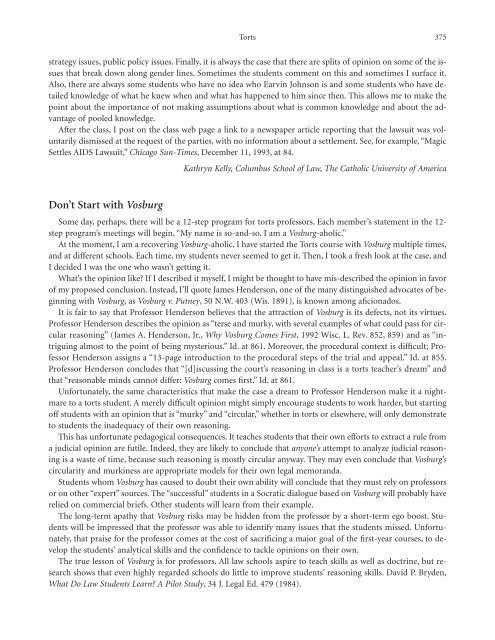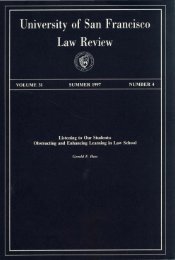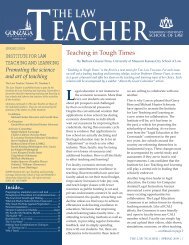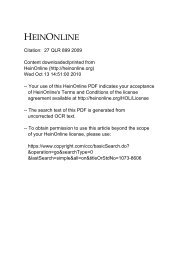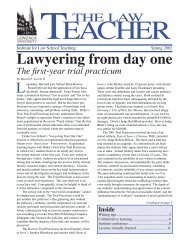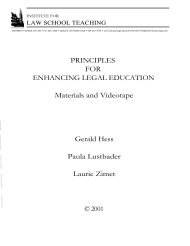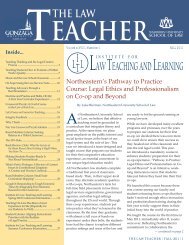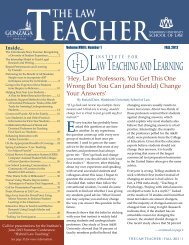Teaching the Law School Curriculum - Institute for Law Teaching ...
Teaching the Law School Curriculum - Institute for Law Teaching ...
Teaching the Law School Curriculum - Institute for Law Teaching ...
Create successful ePaper yourself
Turn your PDF publications into a flip-book with our unique Google optimized e-Paper software.
Torts 375<br />
strategy issues, public policy issues. Finally, it is always <strong>the</strong> case that <strong>the</strong>re are splits of opinion on some of <strong>the</strong> issues<br />
that break down along gender lines. Sometimes <strong>the</strong> students comment on this and sometimes I surface it.<br />
Also, <strong>the</strong>re are always some students who have no idea who Earvin Johnson is and some students who have detailed<br />
knowledge of what he knew when and what has happened to him since <strong>the</strong>n. This allows me to make <strong>the</strong><br />
point about <strong>the</strong> importance of not making assumptions about what is common knowledge and about <strong>the</strong> advantage<br />
of pooled knowledge.<br />
After <strong>the</strong> class, I post on <strong>the</strong> class web page a link to a newspaper article reporting that <strong>the</strong> lawsuit was voluntarily<br />
dismissed at <strong>the</strong> request of <strong>the</strong> parties, with no in<strong>for</strong>mation about a settlement. See, <strong>for</strong> example, “Magic<br />
Settles AIDS <strong>Law</strong>suit,” Chicago Sun-Times, December 11, 1993, at 84.<br />
Don’t Start with Vosburg<br />
Kathryn Kelly, Columbus <strong>School</strong> of <strong>Law</strong>, The Catholic University of America<br />
Some day, perhaps, <strong>the</strong>re will be a 12-step program <strong>for</strong> torts professors. Each member’s statement in <strong>the</strong> 12step<br />
program’s meetings will begin, “My name is so-and-so. I am a Vosburg-aholic.”<br />
At <strong>the</strong> moment, I am a recovering Vosburg-aholic. I have started <strong>the</strong> Torts course with Vosburg multiple times,<br />
and at different schools. Each time, my students never seemed to get it. Then, I took a fresh look at <strong>the</strong> case, and<br />
I decided I was <strong>the</strong> one who wasn’t getting it.<br />
What’s <strong>the</strong> opinion like? If I described it myself, I might be thought to have mis-described <strong>the</strong> opinion in favor<br />
of my proposed conclusion. Instead, I’ll quote James Henderson, one of <strong>the</strong> many distinguished advocates of beginning<br />
with Vosburg, as Vosburg v. Putney, 50 N.W. 403 (Wis. 1891), is known among aficionados.<br />
It is fair to say that Professor Henderson believes that <strong>the</strong> attraction of Vosburg is its defects, not its virtues.<br />
Professor Henderson describes <strong>the</strong> opinion as “terse and murky, with several examples of what could pass <strong>for</strong> circular<br />
reasoning” (James A. Henderson, Jr., Why Vosburg Comes First, 1992 Wisc. L. Rev. 852, 859) and as “intriguing<br />
almost to <strong>the</strong> point of being mysterious.” Id. at 861. Moreover, <strong>the</strong> procedural context is difficult; Professor<br />
Henderson assigns a “13-page introduction to <strong>the</strong> procedural steps of <strong>the</strong> trial and appeal.” Id. at 855.<br />
Professor Henderson concludes that “[d]iscussing <strong>the</strong> court’s reasoning in class is a torts teacher’s dream” and<br />
that “reasonable minds cannot differ: Vosburg comes first.” Id. at 861.<br />
Un<strong>for</strong>tunately, <strong>the</strong> same characteristics that make <strong>the</strong> case a dream to Professor Henderson make it a nightmare<br />
to a torts student. A merely difficult opinion might simply encourage students to work harder, but starting<br />
off students with an opinion that is “murky” and “circular,” whe<strong>the</strong>r in torts or elsewhere, will only demonstrate<br />
to students <strong>the</strong> inadequacy of <strong>the</strong>ir own reasoning.<br />
This has un<strong>for</strong>tunate pedagogical consequences. It teaches students that <strong>the</strong>ir own ef<strong>for</strong>ts to extract a rule from<br />
a judicial opinion are futile. Indeed, <strong>the</strong>y are likely to conclude that anyone’s attempt to analyze judicial reasoning<br />
is a waste of time, because such reasoning is mostly circular anyway. They may even conclude that Vosburg’s<br />
circularity and murkiness are appropriate models <strong>for</strong> <strong>the</strong>ir own legal memoranda.<br />
Students whom Vosburg has caused to doubt <strong>the</strong>ir own ability will conclude that <strong>the</strong>y must rely on professors<br />
or on o<strong>the</strong>r “expert” sources. The “successful” students in a Socratic dialogue based on Vosburg will probably have<br />
relied on commercial briefs. O<strong>the</strong>r students will learn from <strong>the</strong>ir example.<br />
The long-term apathy that Vosburg risks may be hidden from <strong>the</strong> professor by a short-term ego boost. Students<br />
will be impressed that <strong>the</strong> professor was able to identify many issues that <strong>the</strong> students missed. Un<strong>for</strong>tunately,<br />
that praise <strong>for</strong> <strong>the</strong> professor comes at <strong>the</strong> cost of sacrificing a major goal of <strong>the</strong> first-year courses, to develop<br />
<strong>the</strong> students’ analytical skills and <strong>the</strong> confidence to tackle opinions on <strong>the</strong>ir own.<br />
The true lesson of Vosburg is <strong>for</strong> professors. All law schools aspire to teach skills as well as doctrine, but research<br />
shows that even highly regarded schools do little to improve students’ reasoning skills. David P. Bryden,<br />
What Do <strong>Law</strong> Students Learn? A Pilot Study, 34 J. Legal Ed. 479 (1984).


